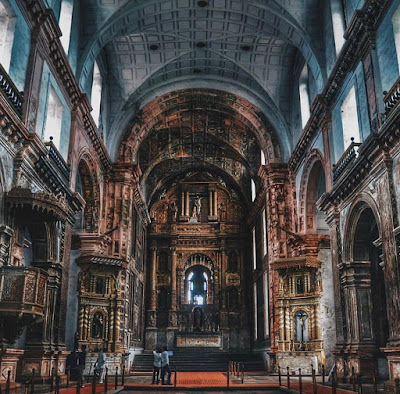Old Goa Town
10 kms East of Panaji, lies the small town of Old Goa, founded by Adil Shah in the first decade of 16th century. It was being developed by them with a view to shifting their capital from Bijapur. However, Afonso de Albuquerquw made a short work of it when he stormed and took it over to house the centre of power of the Portuguese colonies.
1. Basilica of Bom Jesus: The church is dedicated to Bom Jesus meaning Good Jesus or Infant Jesus. Belonging to the Jesuit order this world heritage monument's construction started on 24th November 1594 and was consecrated on 15th May 1605. It is here the Sacred Relics of the body of St. Francis Xavier is kept. A co-founder of the Jesuit order the Saint while returning from Japan during his missionary work got ill and breathed his last at Sancian Island a Chinese province on 3rd Dec 1552. The body was brought to Goa on 16th March 1554 and later in 1613 transferred to the present site. The Coffin is made of silver and the tomb was carved by the well known 17th century Italian Sculptor Giovanni Battistta Fogini. The first exposition of the body for public viewing was in 1622. Since 1891 there have been regular expositions every 10 years, the last being in 2004.
2. Se Cathedral-: Most imposing of all churches at Old Goa. Its vaulted interior overwhelms the visitors by sheer grandeur. This Cathedral has five bells of which one is the famous Golden bell, the biggest in Goa and one of the best in the World. The church is dedicated to St. Catherine.
3. Church of St. Francis of Assisi: The entrance and the choir are in Manueline style, the only fragment of its kind in the East. The interior is illustrated with exquisite paintings. The adjacent convent now houses the Archaeological Museum.
4. St. Augustine church and tower -: The tower and the church itself, were built in 1602 by the Augustinian friars who arrived in Goa in 1587. With the religious suppression in 1835, the Augustinians deserted the church and the convent. The latter was used for some time by the charitable institution of the Misericordia. The buildings fell into neglect resulting in the collapse of the vault on 8 September 1842. The Government appropriated the property, selling the materials the following year. The facade and half of the tower fell in 1931 and some more parts of it collapsed in 1938.
ASI's Mini Circle conducted conservation work in the St. Augustine Church complex. The crevices found in the exposed walls, pillars and pilasters were consolidated. Water-tightening was also carried out on the exposed walls of the adjacent convent.
During the conservation work carried out by ASI's Mini Circle, on one of the side altars of the St. Augustine Church complex, a burial chamber was discovered below the floor in front of the altar. The chamber had a flight of five steps and was built of laterite blocks. It was also plastered in lime-mortar and had a vaulted roof. Inside the chamber, was a grave pit, which contained bones in three places. The pit was also found to be lime-plastered. The chance discovery of the burial assumes a greater significance in the light of the fact that during the last quarter of 1998, a Georgian team visited Goa in order to search for and locate the mortal remains of the Georgian Queen, St. Catevan. The Queen, who died a martyr in 1624, was buried in Goa, presumably in the St. Augustine Church complex. According to the description given in the records, the mortal remains were supposed to have been buried either above the second window near the main altar or between the side chapels on the south-west side in the transept. However, the search did not yield any mortal remains. A detailed study of the present discovery of the grave along with the mortal remains is likely to throw more light on this matter.
5. St. Cajetan Church-: Built in the style of St. Peter’s Basilica in Rome.
6. Church of Our lady of Rosary-: One of the earliest built in Goa, bears an inscription about the conquest of Goa by Afonso de Albuquerque in 1510.
7. Nunnery of Santa Monica-: Built like a fortress is significant for its massive walls and butresses. It is the only nunnery in Goa.
8. Ruins of Church of St. Augustine-: Close to the Nunnery is a lofty tower defying the torrential rains. The tower is one of the four of St. Augustine church that once stood there. The Church when intact was perhaps the biggest in Goa.
9. Viceroy’s Arch-: One of the gates of Adil Shah’s Fort. It was renovated by Portuguese and was the gateway to Goa for Portuguese Governors. Every incoming Viceroy used to disembark at this place.

